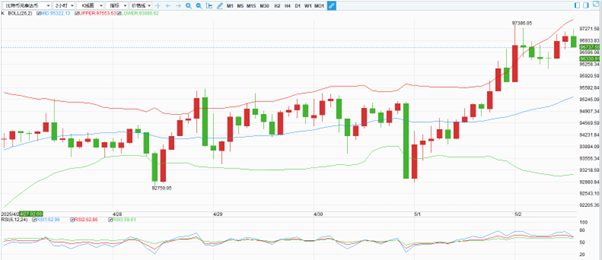The Intersection of Blockchain and Traditional Finance
Imagine a world where financial transactions are seamless, transparent, and accessible to everyone. This is not a distant dream but a reality that is rapidly unfolding at the intersection of blockchain technology and traditional finance. This convergence is reshaping how we think about investments, transactions, and economic stability. Let’s explore the current landscape, focusing on the latest trends and analyses that are driving this transformation.
The Current State of Crypto and Blockchain
The crypto market has been a rollercoaster ride in recent years, with Bitcoin and Ethereum leading the charge. As of May 2025, the market is experiencing a mix of optimism and caution. Bitcoin, the pioneer of cryptocurrencies, continues to be a barometer for the overall market sentiment. Its price movements often reflect broader economic trends and investor confidence.
Bitcoin: The Pioneer
Bitcoin’s journey from an obscure digital currency to a mainstream investment asset is nothing short of remarkable. Its decentralized nature and limited supply have made it a store of value, often compared to digital gold. The recent price fluctuations have been influenced by a variety of factors, including regulatory developments, institutional investments, and macroeconomic trends. For instance, the increasing adoption of Bitcoin by major corporations and financial institutions has bolstered its credibility and stability.
Ethereum: The Platform for Innovation
Ethereum, on the other hand, is not just a cryptocurrency but a platform for decentralized applications (dApps) and smart contracts. Its ecosystem is thriving, with numerous projects leveraging its capabilities to create innovative financial solutions. The introduction of Ethereum 2.0 has further enhanced its scalability and security, making it a preferred choice for developers and investors alike. Ethereum’s ability to support complex financial instruments and decentralized finance (DeFi) applications has positioned it as a key player in the blockchain revolution.
The Rise of Omnichain and DeFi
Omnichain technology is gaining traction as it allows for seamless interoperability between different blockchain networks. This interoperability is crucial for the growth of decentralized finance (DeFi), which aims to create a financial system that is open, transparent, and accessible to everyone. DeFi platforms are disrupting traditional financial services by offering lending, borrowing, and trading services without the need for intermediaries.
DeFi: The Future of Finance
DeFi platforms are revolutionizing the way we think about financial services. By leveraging blockchain technology, these platforms enable peer-to-peer transactions, eliminating the need for traditional intermediaries such as banks and brokers. This not only reduces costs but also increases transparency and accessibility. However, DeFi is not without its challenges. Issues such as smart contract vulnerabilities, regulatory uncertainty, and market volatility pose significant risks.
Liquidity Pools and Yield Farming
One of the most exciting developments in the DeFi space is the rise of liquidity pools and yield farming. These mechanisms allow users to earn passive income by providing liquidity to decentralized exchanges. Liquidity pools enable traders to swap assets without relying on a centralized exchange, while yield farming allows users to earn rewards by staking their assets. However, these activities come with risks, such as impermanent loss and smart contract vulnerabilities. Investors need to be well-informed and cautious when participating in these activities.
The Role of NFTs in the Financial Ecosystem
Non-fungible tokens (NFTs) have emerged as a significant player in the financial landscape. NFTs represent unique digital assets, ranging from art and collectibles to real estate and intellectual property. They have opened up new avenues for investment and ownership, allowing creators and investors to monetize digital content in ways that were previously impossible.
NFTs: A New Asset Class
The NFT market has seen explosive growth, with high-profile sales and collaborations grabbing headlines. Artists, musicians, and athletes are leveraging NFTs to sell digital versions of their work, creating new revenue streams. However, the NFT market is not without its challenges. Issues such as copyright infringement, market manipulation, and environmental concerns related to energy consumption have raised questions about the sustainability and ethics of the NFT ecosystem.
The Environmental Impact
One of the most significant concerns surrounding NFTs is their environmental impact. The energy-intensive process of minting and trading NFTs has led to criticism from environmental advocates. However, efforts are being made to develop more sustainable solutions, such as using proof-of-stake (PoS) consensus mechanisms and renewable energy sources.
Economic Indicators and Market Sentiment
Economic indicators play a crucial role in shaping market sentiment and investment decisions. Nonfarm payrolls, for instance, provide insights into the health of the job market, which in turn affects consumer spending and economic growth. The Federal Reserve’s monetary policy, including interest rates and quantitative easing, also has a significant impact on financial markets.
Nonfarm Payrolls: A Key Indicator
Nonfarm payrolls are a critical economic indicator that reflects the number of jobs added or lost in the U.S. economy, excluding farm workers, government employees, private household employees, and nonprofit employees. A strong nonfarm payroll report can boost market sentiment, indicating a healthy economy and potential for growth. Conversely, a weak report can signal economic troubles and lead to market volatility.
Federal Reserve’s Monetary Policy
The Federal Reserve’s monetary policy, including interest rates and quantitative easing, plays a pivotal role in shaping financial markets. Lower interest rates can stimulate economic growth by making borrowing cheaper, while higher rates can curb inflation. Quantitative easing, or the purchase of assets by the Federal Reserve, can inject liquidity into the market, boosting asset prices and encouraging investment.
The Impact of Global Events on Financial Markets
Global events, such as geopolitical tensions and regulatory changes, can have far-reaching effects on financial markets. For example, the imposition of tariffs by the U.S. government has led to increased costs for businesses and consumers, affecting supply chains and economic growth. Similarly, regulatory developments in the crypto space can either boost or hinder the adoption of blockchain technology.
Geopolitical Tensions
Geopolitical tensions, such as trade wars and political instability, can create uncertainty in financial markets. Investors often seek safe-haven assets, such as gold and government bonds, during times of geopolitical turmoil. This can lead to fluctuations in asset prices and increased market volatility. Staying informed about global events and their potential impact on financial markets is crucial for investors.
Regulatory Developments
Regulatory developments in the crypto space can significantly impact the adoption and growth of blockchain technology. Governments around the world are grappling with how to regulate cryptocurrencies and blockchain-based financial services. While some countries are embracing the technology, others are imposing strict regulations, creating a complex and uncertain landscape for investors and innovators.
The Future of Financial Analysis
As we look to the future, the role of artificial intelligence (AI) and machine learning in financial analysis is becoming increasingly important. AI-driven tools can process vast amounts of data and provide insights that would be impossible for human analysts to achieve. This technology is being integrated into various financial services, from trading algorithms to risk management systems.
AI in Financial Services
AI is transforming the way financial services are delivered and analyzed. AI-driven trading algorithms can execute trades at lightning speed, taking advantage of market inefficiencies and opportunities. Risk management systems powered by AI can identify potential risks and vulnerabilities, enabling financial institutions to make more informed decisions. The integration of AI in financial services is expected to continue, as more industries explore the potential of this technology to enhance efficiency and accuracy.
The Intersection of Real-World Assets and AI
The intersection of real-world assets (RWA) and AI is also creating new opportunities. RWA tokenization platforms, for instance, allow for the digitization of physical assets, making them more accessible and liquid. This trend is likely to continue, as more industries explore the potential of blockchain and AI to transform their operations. The combination of AI and blockchain technology can create more efficient, transparent, and secure financial systems, benefiting both investors and consumers.
Conclusion: Embracing the Future
The convergence of blockchain technology and traditional finance is reshaping the financial landscape in profound ways. From the rise of DeFi and NFTs to the integration of AI and machine learning, the future of finance is being reimagined. As investors and analysts, it is crucial to stay informed and adapt to these changes. The challenges and opportunities that lie ahead will require a blend of innovation, caution, and strategic thinking. Embracing this future means being open to new ideas and technologies, while also being mindful of the risks and uncertainties that come with them. The journey is just beginning, and the possibilities are endless.
—
References

